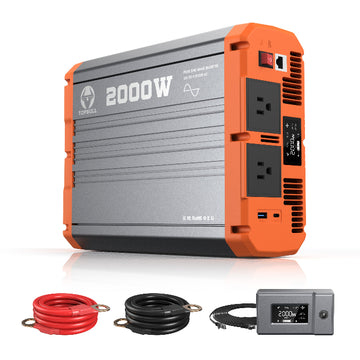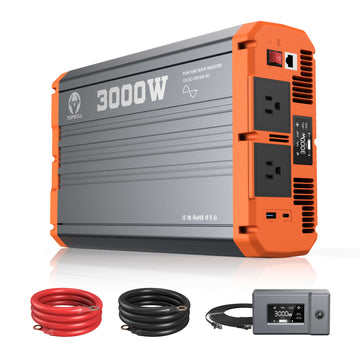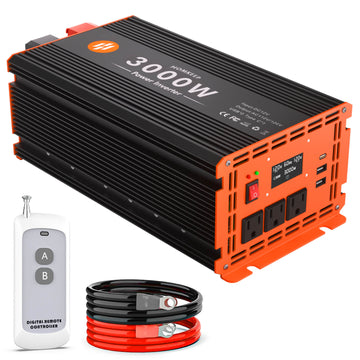Imagine your computer crashing in the middle of an important meeting or your lights running out of power during an outdoor picnic. A 300-watt inverter could be a lifesaver. However, most users will damage the inverter's lifespan due to poor load management. In this article, we will explain in detail the features of the 300W inverter to help you make your choice.
Understanding 300W power inverter
An inverter is an important device that converts DC power into the AC power required by household appliances. It is essential to understand the functions and parameters of the inverter. The power output of a 300W inverter is in the middle level, it can continuously output 300W AC power, which is suitable for some small household appliances.
The peak power, on the other hand, is the instantaneous energy that the inverter explodes in a short period, which is the key guarantee for starting the motor. A quality 300W inverter can provide 450-500W peak power.
Advantages of 300W inverter
- Low price: The cost of a 300-watt inverter is relatively low compared to larger inverters with more power. This is a good option for people who only need to power small devices or appliances - enough for most household appliances without having to pay for redundant power.
- Small size: The 300W inverter is a breakthrough in terms of space utilization and “power in the palm of your hand”. Both the size and weight make it easy to carry with one hand. This makes it ideal for outdoor hiking and emergency evacuation.
Common applications for 300-watt inverters
| Application | Power(Watt) |
| Laptop | 50-100 |
| Mobile Phone | 5-10 |
| LED Lights | 10-15 |
| WiFi Router | 8-10 |
| Projectors | 50 |
Powering home appliances
A 300-watt inverter can power some basic small appliances in your home, such as a small coffee maker, blender, and small microwave. However, other large appliances are far more powerful than what a 300-watt inverter can provide. It is important to carefully calculate whether the power rating exceeds 300 W before using the appliance. Secondly, check that the peak power of the appliance is within the tolerance range of the inverter to avoid overloading the system and potentially damaging the inverter or the appliance itself.
Mobile office
One of the key advantages of a 300W inverter is its portability, which enables it to charge portable electronic devices (e.g., laptops, cell phones) at any time. These devices have become an indispensable part of our life and work, and a small 300W inverter can keep you from power anxiety. At the same time, the inverter is also designed with an AC socket and USB port, which can meet a variety of charging needs.
When using a 300-watt power inverter to power tools and small equipment, it is important to carefully monitor power consumption and ensure that the total load does not exceed the continuous output rating of the inverter. Overloading the inverter can lead to safety issues as well as potential damage to connected equipment or the inverter itself. If your load requirements are excessive, select a more powerful inverter.
Efficiency of 300W inverter
Conversion efficiency usually refers to the energy utilization of an inverter in converting direct current (DC) to alternating current (AC) and is one of the core performance indicators of an inverter, which directly determines the degree of loss and the actual power available during the energy conversion process. A good quality 300W inverter can achieve peak efficiency (about 91%-93%) in the 50% to 80% load range, while the efficiency drops significantly at low loads (below 20%) or near full load (above 95%).
Many other external factors affect the efficiency of inverter operation, such as the type of equipment. Resistive loads (e.g., incandescent lamps, heaters) usually allow the inverter to maintain high efficiency due to their stable power demand, while capacitive or inductive loads (e.g., motors, compressors) introduce additional loop current losses due to the presence of a reactive power component.
Standby power consumption is also an often-overlooked efficiency killer. Even under no-load conditions, some 300W inverters can have a standby power consumption of 8-12W, which is equivalent to 70-105kWh of unnecessary power consumption per year. Quality inverters can compress standby loss to less than 0.5W, improving overall energy utilization.
In addition to this, temperature management is equally critical - the efficiency of inverters decreases in high-temperature environments. Therefore, pay attention to heat dissipation when using inverters and avoid installing them in areas under direct sunlight.
How long will a 300-watt power inverter run
Some users will overuse the 300W inverter, so you may want to know how long the 300W inverter can run. The running time depends on many factors, such as battery capacity, load power, inverter efficiency, and so on.
Running time (hours) = [Battery capacity (Ah) × Batntery voltage (V) × Depth of discharge (DoD) × Inverter efficiency] ÷ Total load power (W)
Battery capacity: Taking a common 12V system as an example, a 100Ah lithium battery can theoretically store 1200Wh (12V x 100Ah) of energy. The higher the capacity of the battery, the longer it will run. However, the actual available energy of the battery will also be limited by the depth of discharge, which is different for different types of batteries. Lead-acid batteries have about 50% of the actual usable energy, while lithium batteries are popular for their depth of discharge of 80% or more.12V 100Ah lithium batteries have an actual usable energy of 960Wh.
Efficiency Loss: We know that inverters are not 100% efficient. Quality 300W inverters are usually 80%-90% efficient.
For example, using a 12V 100Ah Li-ion battery and a 300 inverter (88% efficiency) to drive a 150W load.
Usage time: (100Ah x 12V x 0.8 x 0.88) ÷ 150W = 5.63 hours
How to extend the running time of 300W inverter?
- Avoid running devices at the same time: Multiple devices turned on at the same time can also cause power congestion. Stagger the use of devices to ensure that the total power is always below 300W.
- Choose energy-efficient devices: When buying appliances, you can make limited choices of energy-efficient devices. For example, replacing old light bulbs with LED lights results in a significant reduction in power consumption. Reducing the power demand of your equipment can also extend the life of your inverter.
- Turn off unnecessary devices: Many devices continue to consume power when they are on standby, and these invisible loads can shorten the inverter's range.
- Increase power source: If you want the 300W inverter to last longer during power outages or outdoor activities, you can use it with solar panels. Directly powered by a 100W solar panel on sunny days, battery life increased by 50%
Things to consider when using a 300W inverter
Load management
Strictly check the total power of the load when using the device, it should not exceed the range that the 300W inverter can withstand. The total power of loads used for a long time should be controlled below 270W. For loads that consume more than 200W, the cumulative use should not exceed 3 hours per day.
Heat dissipation management
The temperature of the inverter's internal electronic components will gradually rise during continuous operation. Maintaining air circulation is critical. It is recommended to install the device in a well-ventilated location, making sure to leave at least 10 centimeters of space around it. Avoid direct sunlight for metal casing models and keep plastic casing models away from heat sources. If the surface temperature exceeds 60°C (noticeably hot to the touch), the load should be immediately reduced or use suspended.
Battery maintenance
Maintenance of the battery is crucial when continuous power supply is available, check and maintain the battery regularly.
Regularly check the inverter
Regularly check the appearance and temperature of the inverter and observe whether the voltage output is normal or not.
Learn More: Understanding power inverter repair and maintenance
These conditions must be stopped:
- Smell an obvious burnt odor or see smoke
- Deformation of the casing or melting of the connector
- Abnormal noise (sharp whistling/intermittent clicking)
- Screen flickering/automatic reboot of the connected device
- Output voltage is continuously below 110V or above 130V
FAQ
Q: Will a 300-watt inverter run a TV?
A: Whether or not a 300w inverter can run a TV depends on the power rating of the TV. As long as the actual power of the TV is <250W and a pure sine wave inverter is used, it is safe to run. Avoid using it with other equipment.
Q: Will a 300W inverter run a kettle?
A: Usually not. Most domestic kettles are in the 1500-3000W range, well beyond the carrying capacity of a 300W inverter.
Q: Can I put a 300 w inverter in my car?
A: The cigarette lighter circuit in most cars carries a maximum of about 150 watts, so if you use the cigarette lighter connector directly, the 300 watt inverter may be overloaded, resulting in blown fuses or circuit damage. It is recommended that you connect the 300W inverter directly to the car battery, use a thick enough cable, and install a fuse.
Q: Can a 300W inverter run a refrigerator?
A: Most domestic refrigerators require 500-800W of continuous power, and start-up surges can reach 1500-2500W, well beyond the limits of a 300W inverter. Some mini-fridges may run at less than 300W, but they need to be strictly controlled for the duration of use.













